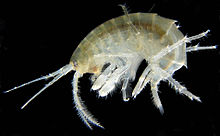Amphipod
| Amphipoda Temporal range: Eocene to Recent
| |
|---|---|

| |
| Gammarus roeseli | |
| Scientific classification | |
| Kingdom: | |
| Phylum: | |
| Subphylum: | |
| Class: | |
| Superorder: | |
| Order: | Amphipoda Latreille 1816
|
| Suborders | |
| |
The Amphipods are an order of malacostracan crustaceans. They have no carapace.
The name amphipoda means "different-footed". Unlike isopods, where all the legs are alike, amphipods have different appendage types.
Of the 7,000 species, 5,500 are classified into one suborder, the Gammaridea. The rest are in two or three other suborders.
Amphipods range in size from 0.1 to 34 centimetres (0.04 to 13 inches) and are mostly detritivores or scavengers. They live in almost all aquatic environments; 750 species live in caves and the order also includes terrestrial animals and sandhoppers such as Talitrus saltator. The largest amphipods live on the sea floor, seven kilometres down.[1]
Reproduction and life cycle
[change | change source]Mature females bear a marsupium, or brood pouch, which holds her eggs while they are fertilised,[2] and until the young are ready to hatch.[3] As a female ages, she produces more eggs in each brood. Mortality is around 25%–50% for the eggs.[2] There are no larval stages; the eggs hatch directly into a juvenile form, and sexual maturity is generally reached after 6 moults.[2]
References
[change | change source]- ↑ Morelle, Rebecca 2012. 'Supergiant' crustacean found in deepest ocean BBC Science and environment.
- ↑ 2.0 2.1 2.2 Sam Wade, Tracy Corbin & Linda-Marie McDowell (2004). "Class Crustacea". Critter Catalogue. A guide to the aquatic invertebrates of South Australian inland waters (PDF). Waterwatch South Australia. ISBN 1-876562-67-6. Archived from the original (PDF) on 2005-06-30. Retrieved 2011-06-09.
- ↑ "Order Amphipoda". Guide to the marine zooplankton of south eastern Australia. Tasmanian Aquaculture & Fisheries Institute. 2008. Archived from the original on 2012-05-18. Retrieved 2011-06-09.
